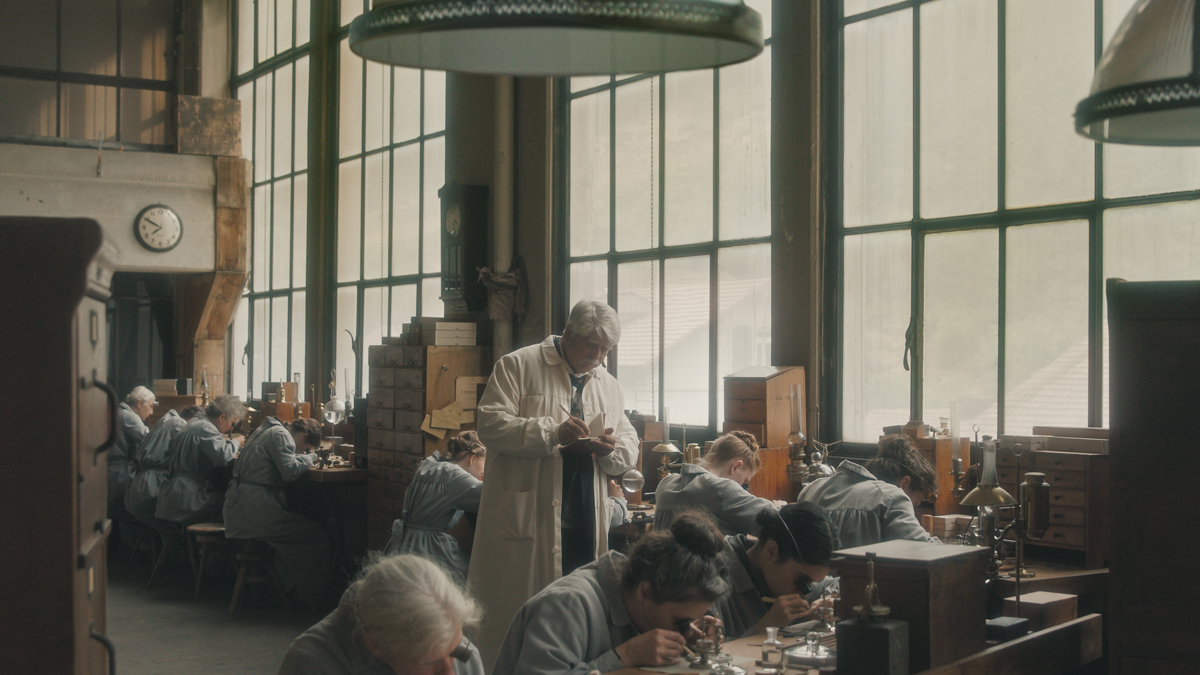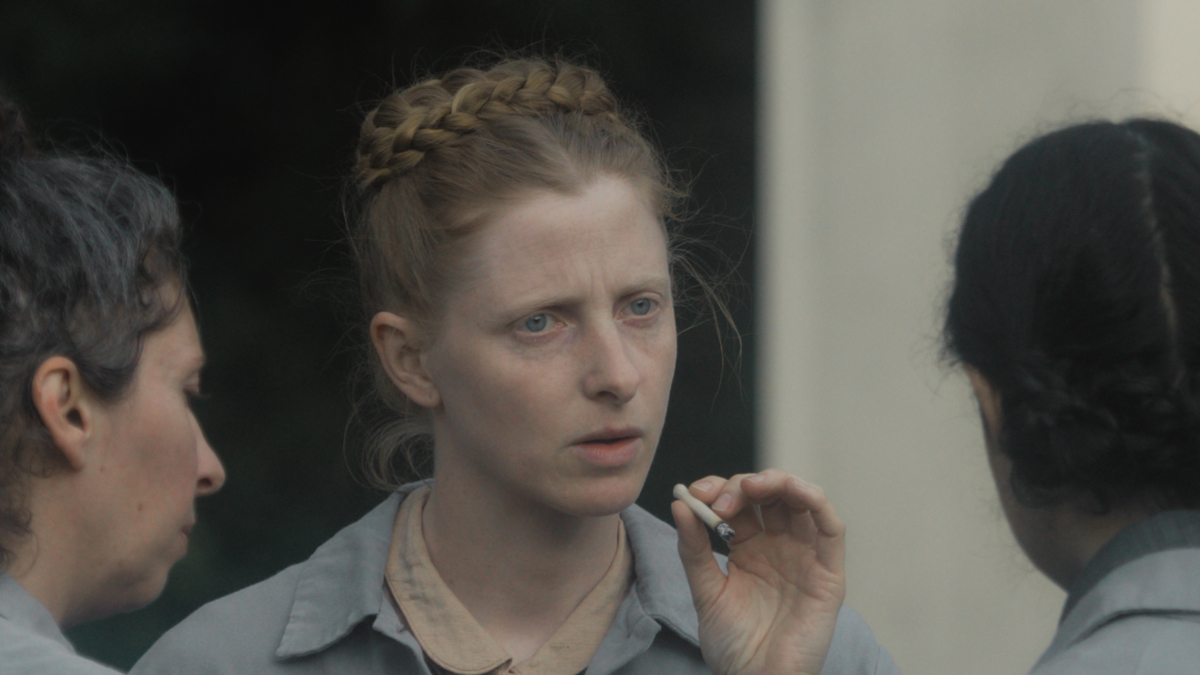 Melissa Anderson
Melissa Anderson
The ticking calm: Cyril Schäublin’s historical drama chronicles a period of anarchist possibility in a Swiss watchmaking town in the 1870s.

Clara Gostynski as Josephine Gräbli in Unrest. Courtesy KimStim.
Unrest, written and directed by Cyril Schäublin, opens May 5, 2023,
Film at Lincoln Center, New York City
• • •
The title of Unrest, an offbeat historical drama from writer-director Cyril Schäublin, reflects a homophonic felicity. Set in the late 1870s in the Swiss town of Saint-Imier, the film focuses on a group of workers (many of them women) at a watchmaking factory tasked with the intricate job of setting the unrest, or balance, wheel in the timepieces—the device that actually measures time, swinging back and forth like a clock’s pendulum. “Unrest” refers not just to the part these laborers specialize in: they, along with others who work in different watch-assembling departments, are also members of an anarchist collective. Yet the name of Schäublin’s feature, his second, could also be thought of as a misnomer: this is an exceptionally placid movie about political agitation.

Still from Unrest. Courtesy KimStim.
The film’s tranquil tone, occasionally punctuated by didactic address, is immediately established in a prologue. Four young Russian women, resplendent in white dresses and toting white parasols, are preparing to have their photo taken outdoors during an afternoon of estival magnificence. While the photographer and his assistant are setting up, this quartet looks at other photos, including one of their cousin, Pyotr Kropotkin, a real-life anarchist and cartographer who has left Saint Petersburg and is now in Switzerland. While sipping from flutes of champagne, they discuss the tenets of their relative’s political beliefs. One asks, perhaps rhetorically: “Which concept will win: anarchism or nationalism?”

Clara Gostynski as Josephine Gräbli and Alexei Evstratov as Pyotr Kropotkin in Unrest. Courtesy KimStim.
Unrest isn’t a speculative fiction. But it does dramatize a little-known (at least to this viewer) episode in European history when that question wasn’t yet firmly decided. Nor is the film a biopic of Kropotkin, though a quote from him serves as an epigraph. (He is played by Alexei Evstratov, who, like most in the cast, is a nonprofessional performer.) Kropotkin is introduced to us newly arrived in Saint-Imier, though it takes a moment to spot him; several scenes in Schäublin’s film are unconventionally arranged, with buildings or roofs dominating the foreground and the speaking characters relegated to the lower left or right of the frame, shot from a considerable distance.

Still from Unrest. Courtesy KimStim.
Kropotkin, in town to make an “anarchist map” of the region—one that will include local place-names that don’t appear on existing ground plans—asks a young woman for directions. She is Josephine (Clara Gostynski), on her way back to the watch factory where she and scores of other women, outfitted in dove-gray coveralls and spanning several generations, produce the unrest wheel. Schäublin—whose grandmother and great-aunts set unrest wheels in northwest Switzerland—and cinematographer Silvan Hillmann film these assembly sequences with rapt attention to detail: extreme close-ups reveal minuscule springs, screws, and rivets, as if seen through the loupes affixed to the right eyes of the distaff laborers. Some workers dip into tins containing pastilles the size and milky color of seed pearls (are these simply candies, or stimulants needed to get through eight hours or more of repeating these exacting tasks?). On the clock, the timepiece-makers are timed: a snowy-haired supervisor with a walrus mustache records the minutes, the seconds it takes the women to complete their assignments—proto-Taylorism that one of Josephine’s colleagues, Mireille (Monika Stalder), who introduces her to anarchism, aims to subvert.

Still from Unrest. Courtesy KimStim.
Nearly everything at the Centralines watch factory (a fictionalized name for Longines, some of whose employees were members of the Anarchist International of Saint-Imier, formed in 1872) is quantified, including how long it takes to walk from point A to point B at the shop. But time itself in the Swiss hamlet is determined by arbitrary whim rather than fixed concept. The town confoundingly operates on four different schedules: municipal time, local time, clergy time, and factory time. A running gag in the film shows two gendarmes constantly adjusting clocks—an action as rooted in bureaucratic caprice as the frequent exhortation made by these same bumbling, affable officers that those engaged in conversation anywhere outdoors move along, for they are interfering with photographs of Saint-Imier to be used in a catalog for Centralines.

Monika Stalder as Mireille Paratte in Unrest. Courtesy KimStim.
Unrest is wry, gentle—maybe too much so. After leaving the factory one evening, Josephine, Mireille, and some of their colleagues are asked by a small group of anarchists if they’d like to buy raffle tickets to support striking workers around the globe. Prizes will be awarded on the same day that the anarchists will stage a play about the Paris Commune; for the benefit of her coworkers and the audience alike, Mireille offers a brief summary of the utopian, worker-led uprising that controlled the French capital for a few months in 1871. It’s telling that we see the raffle (one of the prizes is, perversely, an alarm clock) but not the theatrical production. The phantom play is perhaps merely meant as a nod to British filmmaker Peter Watkins’s 2000 opus, La Commune (Paris, 1871), an inflamed, nearly six-hour reenactment of the insurgency shot as a faux documentary.
Some of the passion, the unruliness of Watkins’s epic would vivify Unrest. Even the film’s most beautiful moments seem pallid when compared with more rousing productions. At that same anarchist celebration, a female choir performs a cappella Charles Keller’s post-Commune anthem “L’ouvrier n’a pas de patrie”—the worker has no fatherland. However ethereal their voices, however noble such lyrics as “tomorrow we will claim a republic of humankind,” the paean ultimately seems no more consequential than the birdsong and other susurrations of nature that constitute Unrest’s diegetic soundtrack. I thought of, and dearly missed, the exhilarating, Bob Fosse–choreographed numbers in George Abbott and Stanley Donen’s 1957 movie musical, The Pajama Game, which centers on management-union discord at the Sleep-Tite Pajama Factory, whose employees are threatening to strike if their demand for an hourly seven-and-a-half-cent raise isn’t met.
If Schäublin’s film about anarchist fervor has the stately, serene aura of a diorama, its notion of time as inherently subjective—as a fantasy as inconsistent and obsolescent as the national borders that the anarchists sought to erase—proves far more stimulating. Unrest’s ideas about the fluidity (at best) and absurdity (at worst) of time were borne out minutes after I left the press screening. Walking to the subway, I heard a sixtyish woman animatedly declare to a newsstand worker, “I’m late today, I’m late today! But I’m early somewhere else.” The worker has no fatherland; the New Yorker has no time zone.
Melissa Anderson is the film editor of 4Columns and the author of a monograph on David Lynch’s Inland Empire from Fireflies Press.